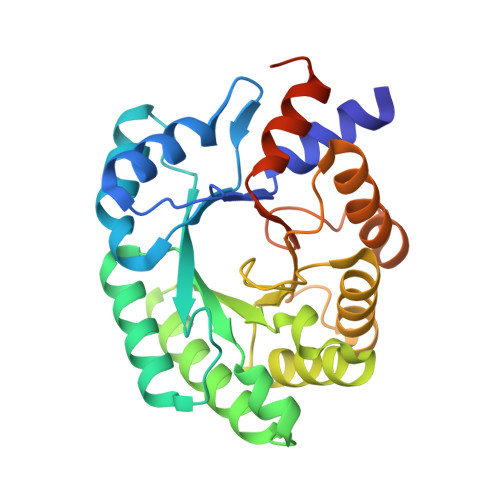Unlocking Asymmetric Michael Additions in an Archetypical Class I Aldolase by Directed Evolution.
Kunzendorf, A., Xu, G., van der Velde, J.J.H., Rozeboom, H.J., Thunnissen, A.W.H., Poelarends, G.J.(2021) ACS Catal 11: 13236-13243
- PubMed: 34765282
- DOI: https://doi.org/10.1021/acscatal.1c03911
- Primary Citation of Related Structures:
7P75, 7P76 - PubMed Abstract:
Class I aldolases catalyze asymmetric aldol addition reactions and have found extensive application in the biocatalytic synthesis of chiral β-hydroxy-carbonyl compounds. However, the usefulness of these powerful enzymes for application in other C-C bond-forming reactions remains thus far unexplored. The redesign of class I aldolases to expand their catalytic repertoire to include non-native carboligation reactions therefore continues to be a major challenge. Here, we report the successful redesign of 2-deoxy-d-ribose-5-phosphate aldolase (DERA) from Escherichia coli , an archetypical class I aldolase, to proficiently catalyze enantioselective Michael additions of nitromethane to α,β-unsaturated aldehydes to yield various pharmaceutically relevant chiral synthons. After 11 rounds of directed evolution, the redesigned DERA enzyme (DERA-MA) carried 12 amino-acid substitutions and had an impressive 190-fold enhancement in catalytic activity compared to the wildtype enzyme. The high catalytic efficiency of DERA-MA for this abiological reaction makes it a proficient "Michaelase" with potential for biocatalytic application. Crystallographic analysis provides a structural context for the evolved activity. Whereas an aldolase acts naturally by activating the enzyme-bound substrate as a nucleophile (enamine-based mechanism), DERA-MA instead acts by activating the enzyme-bound substrate as an electrophile (iminium-based mechanism). This work demonstrates the power of directed evolution to expand the reaction scope of natural aldolases to include asymmetric Michael addition reactions and presents opportunities to explore iminium catalysis with DERA-derived catalysts inspired by developments in the organocatalysis field.
- Department of Chemical and Pharmaceutical Biology, Groningen Research Institute of Pharmacy, University of Groningen, Antonius Deusinglaan 1, 9713 AV Groningen, The Netherlands.
Organizational Affiliation:
















